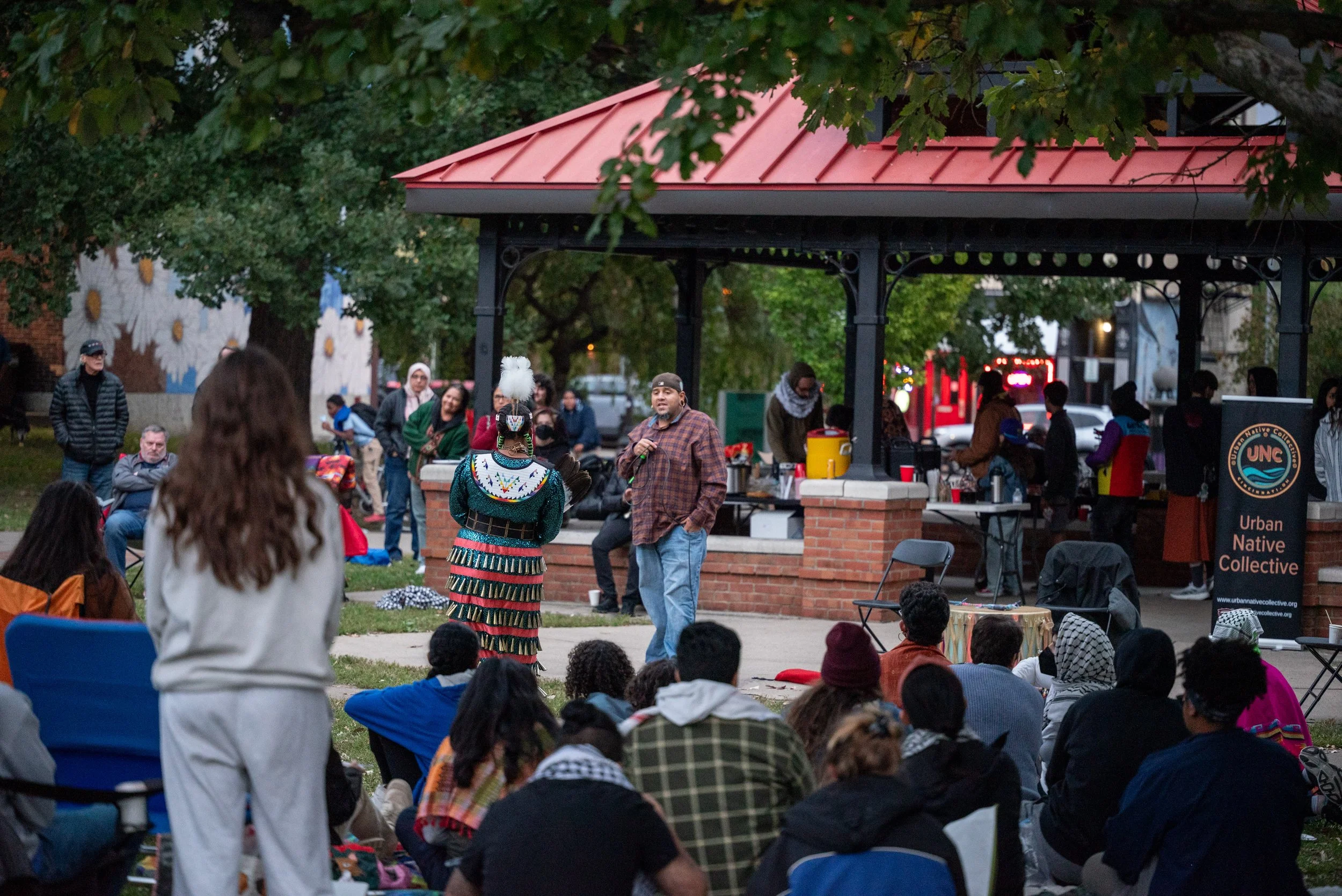2025 Marked the 6th Annual Indigenous Peoples’ Day Convergence in Cincinnati, Ohio.
On Friday, October 10th, the Urban Native Collective kicked off its seventh annual Indigenous Peoples’ Day Convergence with a Gallery Opening Party at the Contemporary Arts Center. The evening celebrated the start of the Ancestral Visions exhibition in the Collective Gallery—featuring the work of eight artists representing communities from across Turtle Island and beyond. At the same time, the Future Dreams exhibition opened at the 21c Museum Hotel, showcasing the multimedia talents of a diverse group of expert and emerging artists. “Our ancestors carried visions for us and for the future they imagined. Ancestral Visions, Future Dreams asks what that future actually looks like today," shared curator Leonard D. Harmon. "This year’s Convergence brings elder artists whose work carries deep knowledge together with emerging artists whose responses point to the future. I wanted the exhibition to move beyond painting, to include textiles, basketry, and natural materials, because ancestral visions live through many forms of creation and continue to guide the art we make now.” Guests enjoyed a thoughtfully curated menu of traditional cuisine prepared by Indigenous Chef, along with music by DJ Creepingbear that set a lively, welcoming tone for the night. Community members spent the evening connecting, sharing stories, and experiencing the powerful range of artwork on display. The celebration concluded with a performance by the Copperface United Powwow Troupe out of North Carolina, who brought Southern-style singing, traditional dance, and cultural education to the stage—ending the night in rhythm, beauty, and community.
The Convergence continued Saturday, October 11th with an intimate Artist’s Speakers Series hosted in the Jarson- Kaplan Theatre of the Aronoff Center for the Arts. Urban Native Collective’s curator Leonard D. Harmon sat down with each of the featured artists in the Ancestral Visions exhibition to discuss their inspiration, craft, and how the theme of the show resonated with their communities and artistic journeys. Artists' talks were interspersed with a screening of Cannupa Lauger’s short film New Myth, and a performance by Copperface United Powwow Troupe. The event offered guests a rare opportunity to engage directly with the artists and performers, sparking dialogue about process, purpose, and the evolving expressions of contemporary Indigenous identity.
On Sunday, October 12th, the Urban Native Collective created a space for connection, creativity, and cultural exchange by hosting artist Roquin Jon Siongco for a traditional CHamoru weaving workshop."We are an incredibly inter-Tribal community," explains Executive Director Briana Mazzolini- Blanchard. "We carry our traditions, and we hold really strong to those. Through our cultural programming at the Urban Native Collective, we are able to offer ... ways for our urban Native community to connect to their traditions, but we all bring different traditions to the table. We, as Native Peoples, are not a monolith." Using natural materials gathered from Siongco’s home on the Island Nation of Guåhan, participants learned time-honored techniques while reflecting on the interconnection of the Land, art, and community. Guided by Siongco’s teachings, community members worked together to weave their own beautiful, hand-crafted pieces—each one carrying stories of tradition and shared learning. This event offered a space to strengthen community ties while honoring the tradition of creating together in kinship.
The Convergence culminated on Monday, October 13th with the Urban Native Collective’s annual Indigenous Peoples’ Day Feast at Hoffner Park in Northside. Community members gathered to share traditional dishes from their respective cultures, in the spirit of solidarity and reciprocity. Local artisans set up booths to display and sell traditional beadwork, sewing, and other hand-crafted goods."It's really an opportunity for non-Natives to grasp the concept of just how many Native people are here in our region; how alive our culture is, and that it's living and breathing and moving and changing," Briana Mazzolini-Blanchard shares. Laughter and conversation filled the air as people shared stories, caught up with friends, and made new connections around the community fire. The evening featured another performance from the Copper Face United Powwow Troupe as well as blessings and reflections offered by community leaders Briana Mazzolini-Blanchard and Guy Jones. The celebration offered a renewed sense of cultural pride and determination with opportunities for knowledge sharing and connection.


















